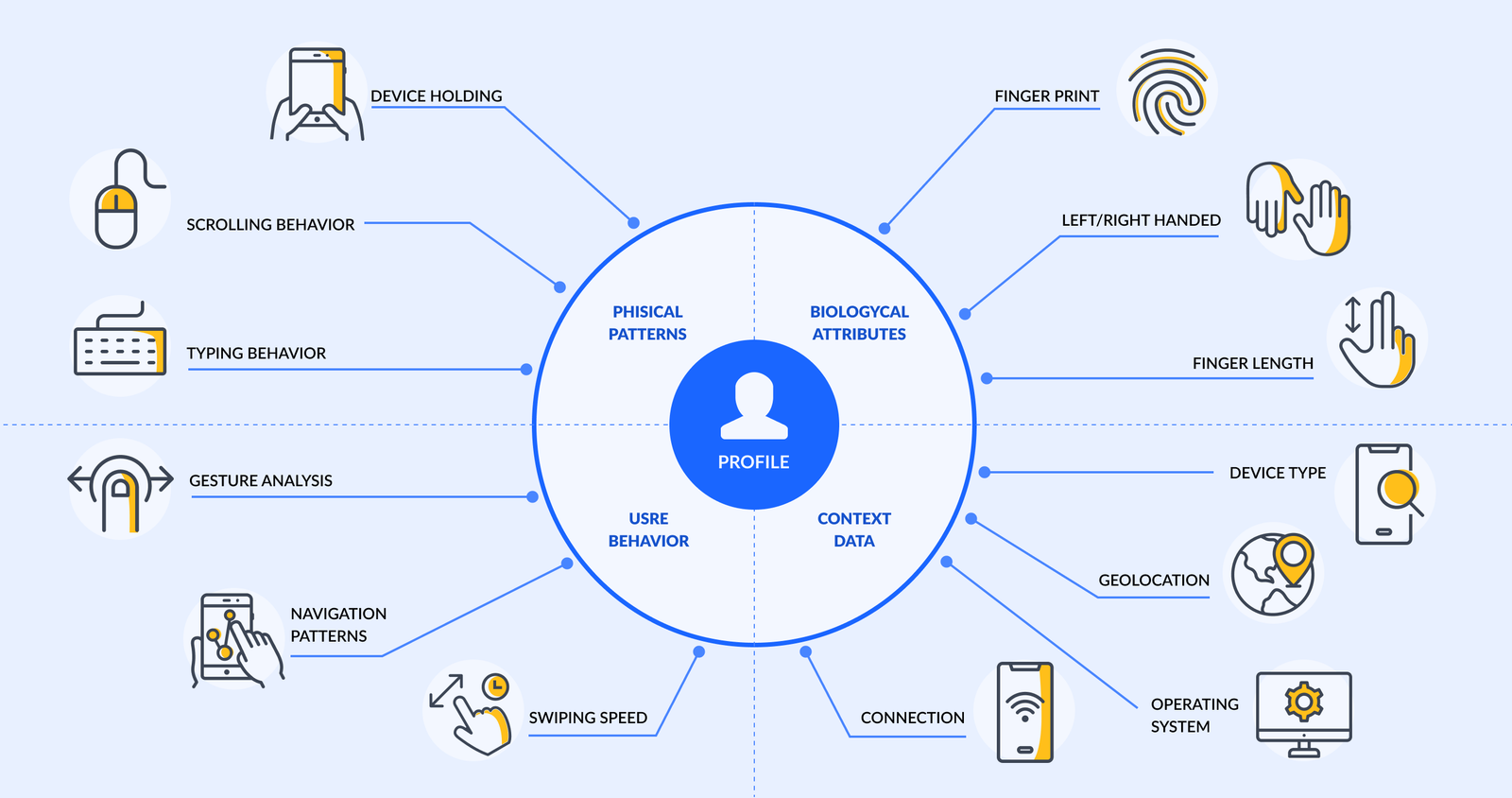Last Updated on 24 Jun 2024
Behavioral biometrics
Share in

Using machine learning algorithms to create individual profiles based on these behaviors, the AI can detect anomalies that may indicate fraudulent activity, and mitigate the risk immediately (account freeze, extra “smart” MFA request, etc.) depending on the perceived risk level.
This kind of cybersecurity defense is extremely valuable as it can uniquely counter a gigantic (and growing) family of cyberthreats, related to account fraud, stolen credentials and identity theft.
According to the INTERPOL report, a sample analysis of 100 dark web services showed a thriving trade in stolen credentials, including credit and debit cards, bank accounts, and personal data.
Bank accounts details (with PIN) retail for about $25 on the dark web , putting enormous stress on traditional cybersecurity protocols consisting only of keyword + 2FA combination.
The report estimates that there are 25.9 million breached Fortune 100 business accounts and 543 million compromised employee credentials available on the dark web. (Direct PDF download)
What are behavioral biometrics?
This includes monitoring how users interact with devices (typing speed, mouse movements, touchscreen gestures), what IP addresses they use, what time they log on typically, and hundreds of other criteria.
We all have a typical signature of how we use our applications, that AI can monitor, to build a behavioral biometric profile. These hundred of data points describe, in time, an extremely specific usage profile.
By comparing that specific usage profile session by session, in the background of the app, we can soon detect a suspected fraudulent access, as a different user will leave a very different usage profile.
These kinds of rapid or brutal changes, identified by AI-powered behavioral biometrics monitoring, are extremely effective early indicators of online fraud.

Behavioral biometrics and 'Red Queen' Cybersecurity Race
Much in the same way that the “Red Queen Race” metaphor (from Alice in Wonderland) represents an ongoing struggle and long term balance between armor and ballistics for example. As one evolved historically so did the other one.
Similarly, the concept of the "Red Queen" race in cybersecurity describes the ongoing struggle between security measures and attackers, where each must constantly evolve to outpace the other.
AI powered behavioral biometrics offer a significant advancement in this race, a form of security that evolves as rapidly as the threats it aims to counter.
Each user interaction provides new data, enabling the AI to refine its understanding of normal behavior and better detect anomalies that may signify an attack, continuously enhancing the security posture without manual updates.
Behavioral biometrics are extremely unique and virtually impossible to replicate without prior knowledge, countering a wide class of cyber attacks (frauds, new account fraud, session hijacking etc.)
Such frauds become virtually impossible to perform, at least with equal success, for a huge majority of modern cyber attackers.
Unique User Identification
Unique user identification has always been the Graal of authentication cybersecurity. Ensuring it is the right user logging in, with the right credentials is a fundamental keystone.
Behavioral biometrics is a game changer for unique user identification in that it is virtually impossible to spoof or mimic the usage patterns of a given account holder. The AI monitors hundreds of criteria in real time.

Behavioral biometrics are a sophisticated cybersecurity method that leverages unique patterns in human activity to verify identities.
The odds of a perfect usage match between two different users are, put simply, unfathomably low.
Unlike physical biometrics (e.g., fingerprints or facial recognition), behavioral biometrics analyzes patterns such as keystroke dynamics, mouse movements, and even walking patterns.
As AI-driven cybersecurity, behavioral biometrics can continuously monitor and assess user behaviors to detect anomalies that may indicate potential security threats.
This technology is becoming vital in applications where sensitive transactions occur, providing a seamless yet secure user experience by authenticating users based on their interactions with devices.
AI Integration and Dynamic Security
This capability is crucial in environments where attackers continually refine their strategies to bypass traditional security measures.
By dynamically analyzing user behavior, AI-enhanced systems can adapt to new threats in near real time, making them indispensable in the escalating arms race against cyber fraud.
Enhancing Security Against Compromised Credentials
Behavioral biometrics also addresses some of the critical challenges in cybersecurity, such as the risk of stolen tokens (or bought on the dark web), stolen credentials or insider threats.
Cybersecurity has always been concerned with preventing account fraud, as well as mitigating quickly and effectively in worse case scenarios when passwords and credentials have already been breached.

Traditional security measures, like passwords and physical tokens, can be compromised, but it is here again virtually impossible for a cyber intruder to mimic the extended usage profile (device, IP, physical and behavioral traits).
This creates a much higher barrier to fraud, significantly enhancing security in scenarios where user verification is crucial.
Specifically in the case of compromised credentials, AI-led behavioral biometrics represent a fairly unique opportunity to mitigate risk and cost potentially in full.
Depending on the cyberposture configured, what behaviors trigger what mitigations, it is possible for a high risk account to be frozen out almost immediately at login.
Should the normal user login from a different set of big indicators (IP address, time, location, device, multiple failed logins, etc.) the AI layer of cybersecurity can outright block them before they can have the chance to make any transaction or steal any data.
This is particularly valuable as cybersecurity mitigation, as it protects “at source” and before damage, unlike most cybersecurity measures which tend to only detect a fraud once it has been committed.
Scalable Defense Against Diverse Threats
Behavioral biometrics offers a scalable solution that can protect against a wide range of threats.
From large-scale automated bot attacks to sophisticated spear phishing and social engineering, behavioral biometrics provides a critical layer of defense that is difficult for cyber criminals to emulate, circumvent or spoof.
Its ability to operate silently in the background ensures that security measures do not impede user experience, making it ideal for both consumer and enterprise applications.
Proactive and Predictive Security Measures
Rather than merely responding to incidents, these systems anticipate and neutralize threats before they manifest into breaches. Being able to predict somewhat the evolution of different types of cyberthreats more accurately also helps developing a sound cybersecurity governance and futureproofed architecture.
As cybersecurity becomes a more prominent concern for individuals and organizations alike, behavioral biometrics in AI applications represents a forward-thinking, flexible, effective and adaptable approach to ensuring digital security.
See How Protecting Customers from the Growing Threat of Account Takeover
Ensure Continuous Security with Real-Time Account Monitoring

See How Protect Your Platform from Account Opening Fraud
CrossClassify uses AI and continuous behavior monitoring to detect and prevent Fake accounts, protecting your business processes

Explore CrossClassify today
Detect and prevent fraud in real time
Protect your accounts with AI-driven security
Try CrossClassify for FREE—3 months
Share in
Related articles
Frequently asked questions
- Keystroke dynamics
- Mouse movement and gestures
- Touch and swipe analysis (mobile)
- Device handling behavior
- Navigation habits and session patterns

Let’s Get Started
Discover how to secure your app against fraud using CrossClassify
No credit card required



